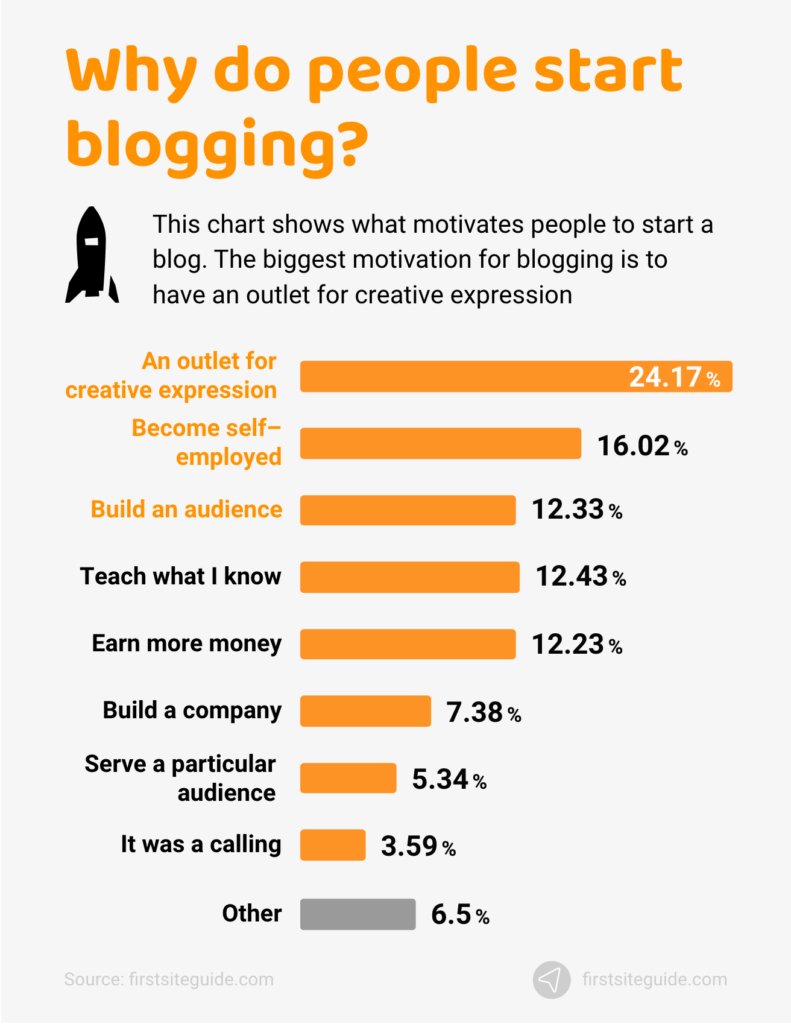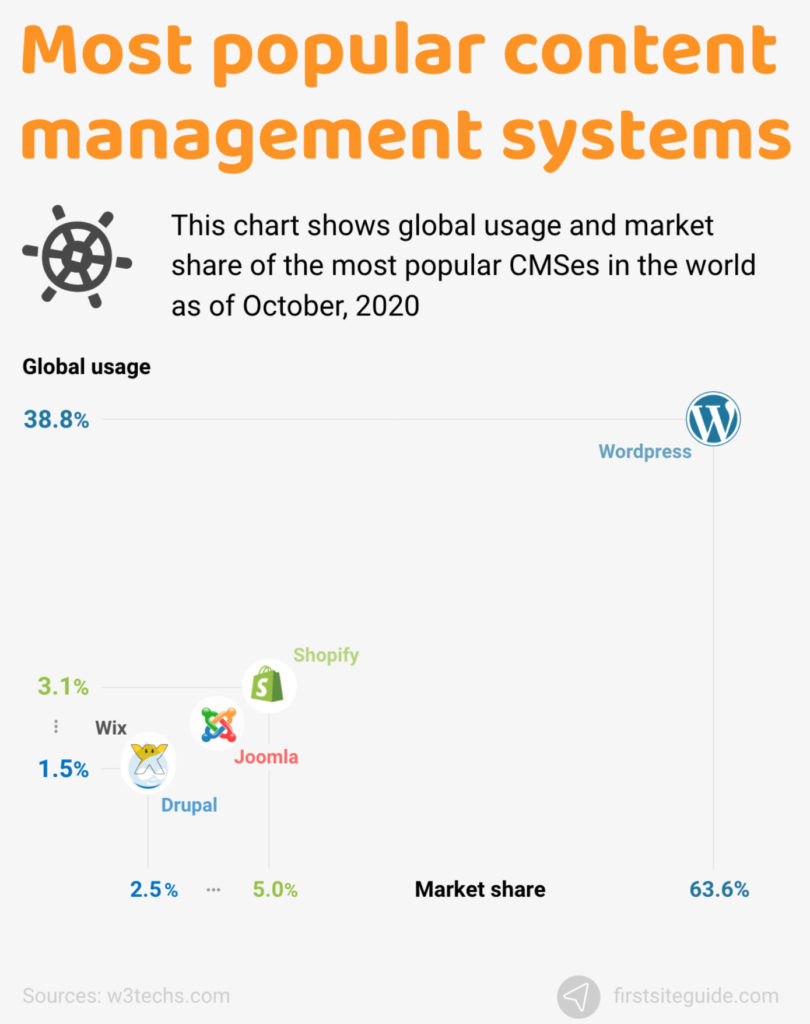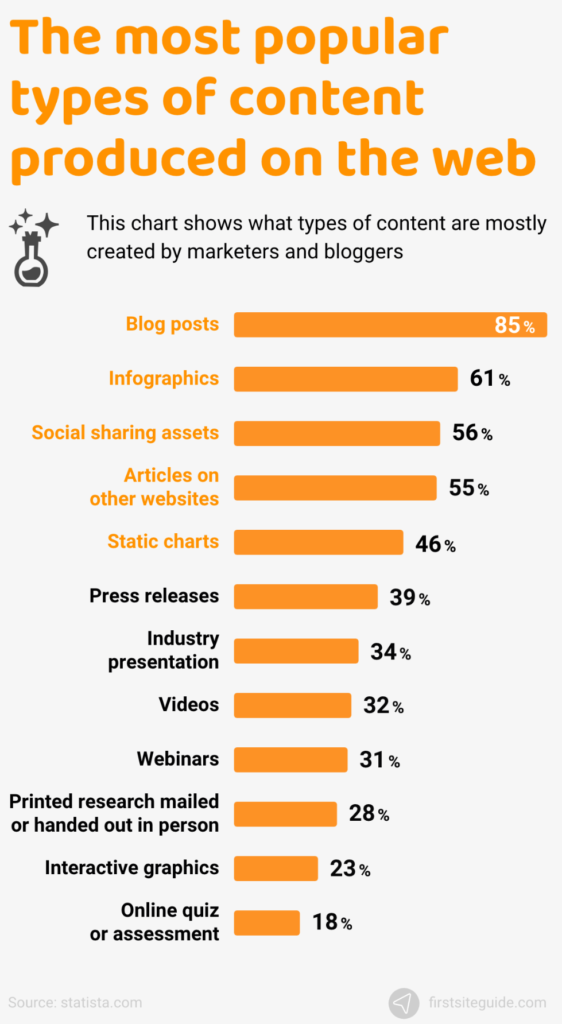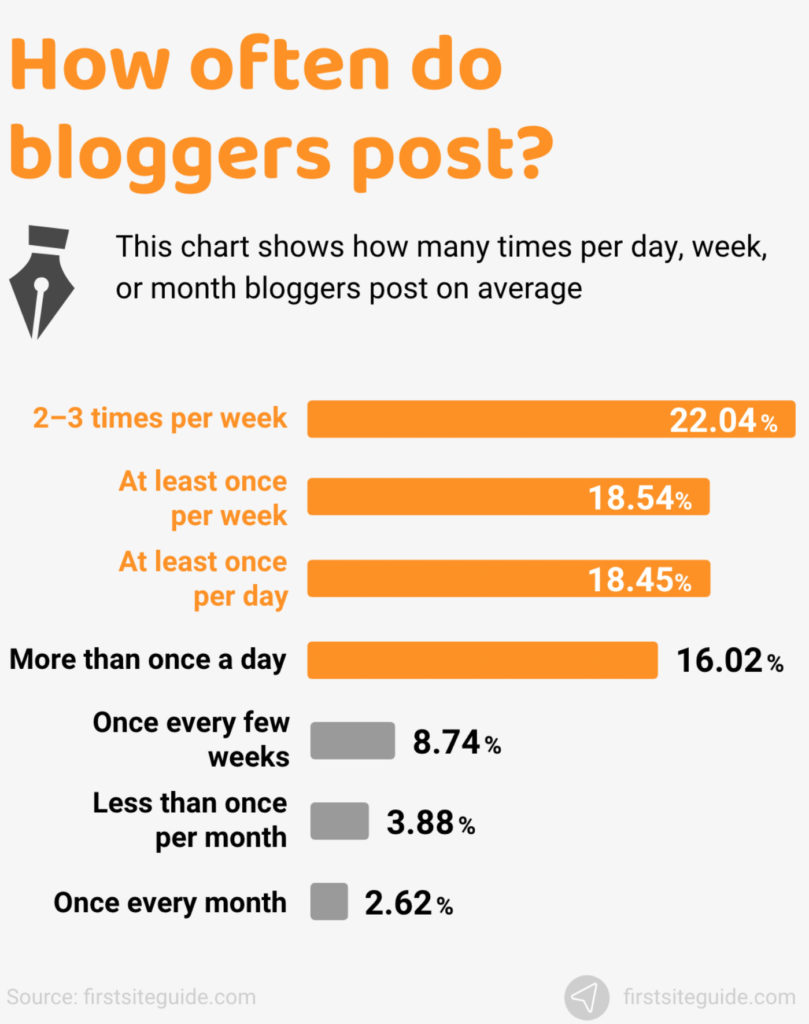According to the Statista Research Department; there are 31.7 million active bloggers in the US alone. So, it is essential to level up your game to survive in this massive, highly competitive blogging market.
Most of the budding bloggers and writers find themselves in a nook for writing, publishing, and updating their blog posts. However, with an active blogging site, the blogger needs to keep pouring in interesting, relevant, and up-to-date content to increase the influx of organic traffic.

So, the first question that may pop up in your mind is that "how many blog posts should I start with." To be honest, there is no right or definite answer to this. Because when it comes to content creation and blogging, it is more about quality than quantity.
Keep reading to understand the dynamics behind successful, high-quality content and money-generating blog posts.

Table of Contents
Importance of Blog Posts
First things first, before we calculate the number of blog posts you need to create each day, it would be smart to the market research as it will also help you explore your "niche" and keep track of the competition. Moreover, it would also help you learn the pattern of blog posting those successful sites use.
Such as Huffington Post, one of the biggest and most popular blogs globally, posts a new blog every minute - every 58 seconds, to be precise. Do you know how many blog posts are published per day? Around 7.5 million.
Quite intense, right. These astounding numbers can confuse you if you are new to the blogging world. Especially if you are operating alone, do you think you can manage a speedy pace?
Of course not. You need to crack the code for blog posting frequency because this code is unique for each person. While Huffington Post creates so many posts each day, another popular blog, Brian Dean, created only 32 blog posts over a year yet acquired almost 1 million visits.
Other world-famous blogging sites like Boost Blog Traffic and James Clear post 1 blog per week, or only once a month.
So, even though a high number of blog posts work great for some people, others might still make the most out of a few blog posts. Because we all have heard, even the slow and steady can also win the race- but only if they are consistent.
Therefore, once you know the prerequisites and have ample knowledge about blogging gathered by reading some detailed guide or by watching different video tutorials, it would be easy to decipher the number of blog posts.

Dig In More Into the Blog Posts Related Statistics
Before blogging, you can search the market and see how the senior bloggers started and made their way to the top. According to research conducted by Oberlo, it takes up to 4 hours on average to create a blog post. However, 67% of the bloggers who post daily have claimed their blogging sites to be successful.
The tip to remember is that several posts do not decide your failure or your success. Instead, it's all about the consistency you can show throughout your journey to becoming a successful blogger alongside the quality and uniqueness of your content.
Suppose you are ready to jump in the pool of bloggers with full-time dedication and creativity, and you got all the essential tools in your favor, such as time, fresh, attractive, and relevant content ideas. In that case, you may start with one blog post and keep posting a new blog every day or with equal time intervals. Successful results are reported by the bloggers who post a blog of more than 3000+ words.
Tips and Tricks to Plan Your Blog Posts
According to Google 2022 updates, a minimum of 24 blog posts every day can boost the traffic by 30%, while more than 50 posts per day can boost the organic traffic by at least 77%.
We do not mean to worry you but to warn you. So, if you plan to launch a new blog or an oldie who the newcomers overshadow and need to outperform, we have a few fail-proof tips and tricks to help you out.
Pen down your goals
The ultimate rule of business success is to decide your target audience because you have nothing if you have no audience. List down the methods of content marketing strategy you want to use, such as social media marketing, email marketing, and more, take the necessary steps to create awesome blog content, and rank up your site on search engines.
Once you set your goals, you can easily reach out to the target audience through your content. Remember, even if you post 1000 blog articles every day, but you do not have enough visitors- there is no use. So, to get your relevant traffic using the following savvy content creation tactics:
- Write engaging guest posts and other relevant blog posts to get more audience and to keep the existing visitors
- Cover as many blog topics as you can- the more queries you answer, the more traffic you get.
- Invest time and even money on Search Engine Optimization SEO inbound-marketing, blog layout, and URL.
- Spread the word about your blogs on your social media channels (on individual posts) by including backlinks to divert your audience to your blog posts.
- Ensure a high-quality blog post with only valuable content and no grammatical errors.
- Evaluate what works for you! or what kind of blog theme will be convenient for you to carry.
Audience engagement will help you decide the number and types of blogs you need to post to succeed. For example, another famous blog writer Neil Patel initially started experimenting with 1 post per week that led more than 46,000 visitors to his blog. Then he tested 2 blog posts per week, and amazingly, his audience increased to 100,000 views.
So, first, use your content to get the traffic and then use that traffic to decide the type of content you need to create alongside the frequency of blog posts you need to upkeep.
Evaluate the results of already published blog posts
If the content on your blog is getting enough traffic, you can pour in more posts. However, if the audience plateau is stagnant or decreasing, you need to take a step back and focus on the quality of your posts instead of cramming your site with irrelevant content.
Once you achieve the desired or above par cornerstone with your blog content plan, you can stick to an easy-to-manage and regular content schedule - and even lower the publishing frequency of the blog posts on a regular basis.
To give you a general overview, here is how you can evaluate the blog's performance according to the type of your business and then work on a basic plan.
According to Google 2022 updates, B2B companies can get 3 times more leads by publishing more than 400 blog posts than when they publish less than 400 blogs. Similarly, for the B2C companies, you can generate 4.5 times more leads by posting more than 400 posts compared to when you publish 0 to 100 posts.
The basic plan for beginner bloggers is to analyze their content management system and evaluate the number of already published blogs you have. Then, track the milestones achieved for every 100, 200, 300, and more posts you published on the specific dates.
Using WordPress, you can use their simple blog stats plugin to track the statistics. However, if you are not on WordPress, you can use Google Analytics to check the monthly numbers about the visitors, posting frequency, etc. Most of the time, it is the test and trial thing you need to practice ranking up your blog writing services on search engines like Google.

Keep an eye on the traffic generating channels.
The traffic and posting criteria are different on social media networks than on search engines. Studies have shown that posting content on social channels like Twitter, Instagram, Facebook does not last for more than a day.
So, if the content is not ranking for more than a day, how is it supposed to drive continuous traffic for your blog posts? Therefore, even though you can use social networks to spread the word about your blog, the search engine optimization SEO rankings and visibility are more stable.
If you manage to stay on the front page of search engines with meaningful content, your blog site will be invincible.
Consider the audience's demands and act accordingly.
Your audience will not be scrolling on your blog 24/7. Instead, they would spare a specified time for your blog each day or once a week. And they would want to see valuable content and not complex topics they do not understand.
User experience on-site blogs can quickly go downhill if they fail to keep their blogs in the "evergreen content" category. Similarly, increasing the frequency of blog posts at a pace that the audience cannot keep up with can lead to un-subscriptions.
For example, during their 6-months experimental HVLC phase, HubSpot Blog witnessed a huge number of users unsubscribing their email newsletters because they increased the frequency of blog posts per week without considering the audience preferences and demands.
So, you have to be extremely mindful of the content distribution and creation. Here are some of the excellent content choices that can help your small business grow into a blooming site with massive traffic in no time:
- TOFU blog posts- create articles with light, fun-to-read content that stick to the Latest Internet trends and business-related subjects
- In-depth tactical or comprehensive articles
- Blogs with above par visual content such as infographics and slide shares
- Add posts with special announcements that talk about promo codes, discounts, new releases
- Content for personal blogs, such as life experiences, etc
The more your content revolves around the audience's expectations, the better.

Stay consistent to find your "sweet spot."
To balance your business goals and audience demands, search for the volume experiments done by various blogs for posting. Find a common pattern or theme between their statistical growth to modify and implement.
Do not exhaust yourself by increasing the publishing frequency that you cannot manage just for the sake of more traffic. For example, Kevin Muldoon, a famous blogger, and Youtuber increased his posting frequency to 5 posts per week from 1 post per week with his popular blog when he started out in 2000. Even though the turnout was great, the traffic increased by 46%, which came at the cost of his mental and physical health. He soon reached his burnout point, and he could not upkeep the blog site's performance.
Therefore, never increase the frequency increasingly, especially if you are the only one managing the blog. It can also lead to lesser user engagement with a drastic decline in social shares and comments on the blog posts. CoSchedule witnessed the same when they increased their posting frequency to 3 posts per week from 2 posts per week.
So, do not choose quantity over quality. Instead, create an editorial calendar and stick to the initial ideal frequency and see if things work out for you.
If you are wondering how many words each blog post should contain, then again, you would have to evaluate what works for you. But ideally, long, engaging articles (probably 1000-2000 words) generate better results.
Moreover, if you are a beginner, you can start with 5-10 blog posts per week or a minimum of 1-2 posts per day with optimized content to rank your blog higher on the search engines.
Plan a Blog Launch Strategy
You can get extremely confused and overwhelmed while stepping into the blogging market. To decide the frequency of blog posts, it is essential to emphasize the blog launch strategy to navigate organic traffic to your site. Depending on your experience and the quality of the content, you can decide on starting with either a simple blog launch or a comprehensive one.
To know which one suits you best, check out the following day-to-day overview to reach an informed decision.
Simple blog launch
- Day 1 as a blogger can be pretty challenging, have a soft launch and post your initial blog. Then, spend the rest of your day enhancing your site features, collecting viewers' opinions, and planning your future blog posts. This will ease off some pressure and provide you with ample processing time.
- On day 2 launch, your second post promotes it on different social media platforms such as Pinterest, Facebook, Twitter, etc.
- Arrange a little launch party on your 3rd day by publishing your blog post as a whole article in Facebook groups, going live on Instagram or on Facebook to target your audience and try to connect with them, creating promo graphics for Twitter, sending some personal messages to blogger friends asking them for a favor on your initial blogs such as they can recommend your blogs to their followers, etc., and offer them a favor in return.

Comprehensive blog launch:
- Prelaunch some interesting content to build your audience's curiosity, post reminders, teaser clips, giveaways, or some interesting but incomplete matter from your upcoming blogs. You can give away some facts to your audience which show them how your original blog could change their lives.
- Starting from day 1, create and launch one blog post and then continue a steady blogging frequency by publishing 2 or 3 posts a day and promoting your blogs organically, as much as you can manage.
- Run ads on different social media platforms or any blog platform to target the audience. Avoid focusing only on bloggers and target a larger audience without mentioning specific ages, interests, or locations. All these activities should circle one motto: to promote your bundles and giveaway.
- Try to search for a blogging platform or any other social media platform where your audience hangs out and promotes your blog post there. Always ask your family and friends to help you with your promotion campaign.
- On day 3, blog a post and promote it following a similar protocol. Then, continue to follow a regular schedule by posting a blog on a daily basis for the next few weeks. After a month, you can slow your pace down, which will make it manageable for you in the long term.
The strategy is simple, publish an introductory post. Then publish a new blog post every day in the first week, and then publish a blog post every alternate day in the second week, and then you can choose your pace, such as 1 or 2 blog posts a week and so on. By following this simple strategy, you need almost 12 posts ready for your launch.
This strategy usually works for new bloggers because this approach delivers your readers something new every day to create a habit. This habit will assure you of their return, resulting in a successful blog. In addition, this approach will assure you of a high rank with search engines and a better SEO-optimized website. If everything goes as planned, you are surely in a good position to attract organic traffic.

Conclusion
These are a few tips that can help new bloggers have a dynamic start to their blog. Creating content relevant to your audience and attaining a high ranking with search engines is not an easy task; remain patient and never lose your calm in strategizing these blogging routines.
Once you have achieved your goal to be a successful blogger, you must maintain that reputation. A post once a week would be enough for successful blogs to show their credibility, sit back and enjoy your success with a cup of tea. It's high time then to enjoy watching your readership grow.
You will have to be an all-rounder if you handle your blog alone. You would have to create content, design the website, optimize the blog, and make sales. Frequently, the quality would be compromised because your plate will be full, and publishing frequency will decline.
However, with a larger team, you can divide the responsibilities, and each person can focus on the relevant things to keep at par with the number of blog posts the site needs every day.
Never post irrelevant or invaluable content just for the sake of keeping up with daily or weekly blog posts numbers. It can have an adverse effect on your blog and lead to the audience unsubscribing to your content because they do not find it useful anymore.
So, there is no rule of thumb for blog posting frequency, and you have to experiment your way into it. But, remember, consistency is the to make your blog successful!


